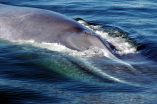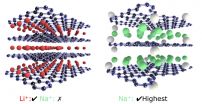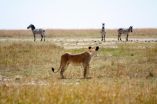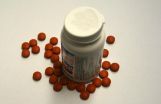NASA's IMAGE and Cluster missions reveal origin of theta auroras
2014-12-18
(Press-News.org) Auroras are the most visible manifestation of the sun's effect on Earth, but many aspects of these spectacular displays are still poorly understood. Thanks to the joint European Space Agency and NASA's Cluster mission combined with data from a past NASA mission called the Imager for Magnetopause-to-Aurora Global Exploration, or IMAGE, a particular type of very high-latitude aurora has now been explained.
Known as a theta aurora -- because seen from above it looks like the Greek letter theta, an oval with a line crossing through the center -- this type of aurora sometimes occurs closer to the poles than normal aurora. While the genesis of the auroral oval emissions is reasonably well understood, the origin of the theta aurora was unclear until now. A paper in the Dec. 19, 2014, issue of Science shows that hot plasma funneled into near-Earth space from the sun helps cause these unique aurora.
"The possibilities have been debated since the first satellite observations of the phenomenon were made in the 1980s," said Robert Fear of the University of Southampton in the U.K. (formerly at the University of Leicester), and lead author of the Science paper.
Although separated by some 93 million miles, the sun and Earth are connected by what's known as the solar wind. This plasma - electrically charged atomic particles - streams from the sun and travels across the solar system, carrying its own magnetic field along for the ride.
Depending on how this interplanetary magnetic field is aligned in relationship to Earth's magnetic field, there can be various results when the solar wind arrives at near-Earths space. At the point where the two fields meet, Earth's magnetic field points north. If the interplanetary field points in the opposite direction -- south -- then something called magnetic reconnection occurs, causing magnetic field lines pointing in opposite directions to suddenly realign into a new configuration.
The realignment opens the door so that solar wind material can funnel into the magnetosphere - the giant magnetic bubble surrounding Earth. This is what leads to the aurora, which is produced when the particles funnel down along Earth's magnetic field lines and strike atoms high in the atmosphere. The interaction with oxygen atoms results in a green or, more rarely, red glow in the night sky, while nitrogen atoms yield blue and purple colors. Normally, the main region for this impressive display is the auroral oval, which lies at around 65-70 degrees north or south of the equator, encircling the polar caps.
But when the interplanetary magnetic field points northward, auroras can occur at even higher latitudes, sometimes resulting in theta aurora. Prior to the recent work, scientists suspected that theta aurora had something to do with the particles observed in the lobe regions of the magnetosphere. The plasma in the lobes is normally cold, but previous observations suggested that theta auroras are linked with unusually hot lobe plasma - but just how was unclear.
"It was unclear whether this hot plasma was a result of direct solar wind entry through the lobes of the magnetosphere," said Fear. "Or if the plasma is somehow related to the plasma sheet on the night side of Earth. One idea is that the process of magnetic reconnection on the night side of Earth causes a build-up of trapped, hot plasma in the higher latitude lobes."
The mystery was finally solved by studying data collected simultaneously by the Cluster and IMAGE spacecraft on Sept. 15, 2005. While the four Cluster satellites were located in the southern hemisphere magnetic lobe, IMAGE had a wide-field view of the southern hemisphere aurora. As one Cluster satellite observed uncharacteristically energetic plasma in the lobe, IMAGE saw the arc of the theta aurora cross the magnetic footprint of Cluster.
The team found that the energetic plasma appeared on high-latitude magnetic field lines that had been closed by the process of magnetic reconnection driven by the northward pointed fields. This in turn caused the plasma to become relatively hot. Such observations support the idea that theta aurora are due to plasma trapped inside the magnetosphere, rather than material being directly pushed in from the solar wind.
"Solving the question of the origin of the theta aurora required Cluster's high inclination orbit that sweeps over the region where the aurora are generated together with the imaging capability of IMAGE, which is no longer functioning," said Melvyn Goldstein, Cluster project scientist at NASA's Goddard Space Flight Center in Greenbelt, Maryland. "Hopefully, future missions will give comparable capabilities to view the polar regions of the magnetosphere."
Cluster consists of four satellites flying in formation around Earth. The data presented in this report were collected by Cluster-1. The Cluster mission was launched in 2000 and is still operating. IMAGE was launched in 2000 and concluded operations at the end of 2005. The data presented in this report were collected by the satellite's far-ultraviolet Wideband Imaging Camera.
INFORMATION:
European Space Agency and Karen C. Fox
NASA's Goddard Space Flight Center, Greenbelt, Maryland
[Attachments] See images for this press release:

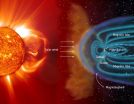
ELSE PRESS RELEASES FROM THIS DATE:
2014-12-18
ITHACA, N.Y. - To encode data, today's computer memory technology uses electric currents - a major limiting factor for reliability and shrinkability, and the source of significant power consumption. If data could instead be encoded without current - for example, by an electric field applied across an insulator - it would require much less energy, and make things like low-power, instant-on computing a ubiquitous reality.
A team at Cornell University led by postdoctoral associate John Heron, who works jointly with Darrell Schlom, professor of Industrial Chemistry in the ...
2014-12-18
Scientists from WCS (Wildlife Conservation Society), the Universidad Austral de Chile, the Blue Whale Center, the American Museum of Natural History (AMNH), NOAA, and other organizations are examining molecular clues to answer a big question: how many types of blue whales exist in the waters of the southeastern Pacific?
The answer seems to be two distinct populations, according to a genetic study comparing the blue whales off the southern coast of Chile with those swimming in the waters of Antarctica and other nearby regions. One of the populations could be made up of ...
2014-12-18
By 2050, a majority of U.S. coastal areas are likely to be threatened by 30 or more days of flooding each year due to dramatically accelerating impacts from sea level rise, according to a new NOAA study, published today in the American Geophysical Union's online peer-reviewed journal Earth's Future.
The findings appear in the paper From the Extreme to the Mean: Acceleration and Tipping Points for Coastal Inundation due to Sea Level Rise, and follows the earlier study, Sea Level Rise and Nuisance Flood Frequency Changes around the United States, by the report's co-author, ...
2014-12-18
MANHATTAN, KANSAS -- A Kansas State University engineering team has discovered some of graphene oxide's important properties that can improve sodium- and lithium-ion flexible batteries.
Gurpreet Singh, assistant professor of mechanical and nuclear engineering, and Lamuel David, doctoral student in mechanical engineering, India, published their findings in the Journal of Physical Chemistry in the article "Reduced graphene oxide paper electrode: Opposing effect of thermal annealing on Li and Na cyclability."
Graphene oxide is an insulating and defective version of graphene ...
2014-12-18
Many genetic mutations in visual pigments, spread over millions of years, were required for humans to evolve from a primitive mammal with a dim, shadowy view of the world into a greater ape able to see all the colors in a rainbow.
Now, after more than two decades of painstaking research, scientists have finished a detailed and complete picture of the evolution of human color vision. PLOS Genetics is publishing the final pieces of this picture: The process for how humans switched from ultraviolet (UV) vision to violet vision, or the ability to see blue light.
"We ...
2014-12-18
Ibuprofen, a common over-the-counter drug used to relieve pain and fever, could hold the keys to a longer healthier life, according to a study by researchers at the Buck Institute for Research on Aging. Publishing in PLoS Genetics on December 18th, scientists showed that regular doses of ibuprofen extended the lifespan of yeast, worms and fruit flies.
"There is a lot to be excited about," said Brian Kennedy, PhD, CEO of the Buck Institute, who said treatments, given at doses comparable to those used in humans, extended lifespan an average of 15 percent in the model ...
2014-12-18
Many animals may have a previously under-appreciated ability to make up for lost time with more effort, according to new research publishing this week in PLOS Computational Biology.
This capability could help scientists better understand how animals make efficient decisions in changing environments -- and ultimately help ensure the survival of a species.
Researchers from Princeton University challenge the conventional view that animals face a simple trade-off between the speed and the accuracy of their decisions. Adrian de Froment, Daniel Rubenstein and Simon Levin ...
2014-12-18
Most vaccines work by inducing an immune response characterized by neutralizing antibodies against the respective pathogen. An effective HIV vaccine has remained elusive so far, but researchers have continued to make progress, often employing innovative methods. A study published on December 18th in PLOS Pathogens reports that a combination of antibodies from llamas can neutralize (destroy) a wide range of circulating HIV viruses.
After initial disappointment that HIV vaccine candidates were unable to elicit neutralizing antibodies, researchers found that some HIV-infected ...
2014-12-18
COLLEGE STATION -- A common over-the-counter drug that tackles pain and fever may also hold keys to a longer, healthier life, according to a Texas A&M AgriLife Research scientist.
Regular doses of ibuprofen extended the lifespan of multiple species, according to research published in the journal Public Library of Science-Genetics.
"We first used baker's yeast, which is an established aging model, and noticed that the yeast treated with ibuprofen lived longer," said Dr. Michael Polymenis, an AgriLife Research biochemist in College Station. "Then we tried the same process ...
2014-12-18
This news release is available in Japanese, French, Spanish and Chinese on EurekAlert! Chinese. The Rosetta spacecraft caught up with the comet known as 67P/Churyumov-Gerasimenko beyond Mars this August, and its preliminary results--along with the studies it will allow in the near-future--top this year's list of the most important scientific breakthroughs, according to the editors of Science.
This annual list of groundbreaking scientific achievements, selected by Science and its international nonprofit publisher, AAAS, also includes groundbreaking advances in medicine, ...
LAST 30 PRESS RELEASES:
[Press-News.org] NASA's IMAGE and Cluster missions reveal origin of theta auroras


